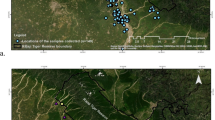Abstract
Non-invasive genetic analyses are important for studies of species that are rare, sensitive or at risk of extinction. This study investigates the possibility of using faeces and urine to obtain microsatellite genotypes for individual identification of wolverines (Gulo gulo). The reliability of the employed method was assessed by analysing independent amplifications of non-invasive samples (a multiple-tube approach) and by comparing genotypes obtained from faeces to genotypes obtained from blood or tissue of the same individual. Ten microsatellite markers were successfully amplified in 65% of the faecal samples (n = 32) and 40% of the urine samples (n = 22). Allelic dropout was found in 12 and 14% of the amplifications from extracts of faeces and urine, respectively. Nevertheless, all multi-locus genotypes were correct, as judged from comparison to data from tissue or blood samples, after three replicates. These results suggest that a non-invasive approach based on DNA-analysis of faeces can be a powerful tool in population monitoring of wolverines, potentially providing reliable estimates of population size and immigration rate. A second objective of the study was to develop markers for DNA-based sex identification in wolverines using non-invasive samples. We developed two Y-linked markers, one that was specific to wolverine and one that also successfully identified sex in another mustelid. Importantly, none of the markers amplified potential prey species such as reindeer or rodents.
Similar content being viewed by others
References
Davis CS, Strobeck C (1998) Isolation, variability and cross-species amplification of polymorphic microsatellite loci in the family Mustalidae. Mol. Ecol., 7, 1776–1778.
Duffy AJ, Landa A, O’Conell M, Stratton C, Wright JM (1998) Four polymorphic microsatellites in wolverine, Gulo gulo. Anim. Genet., 29, 63–72.
Ernest HB, Penedo MCT, May BP, Syvanen M, Boyce WM (2000) Molecular tracking of mountain lions in Yosemite Valley region in California: Genetic analysis using micro-satellites and faecal DNA. Mol. Ecol., 9, 433–441.
Flagstad Ø, Røed K, Stacy JE, Jakobsen KS (1999) Reliable noninvasive genotyping based on excremental PCR of nuclear DNA purified with a magnetic bead protocol. Mol. Ecol., 8, 879–883.
Greenwood JJ (1996) Basic techniques. In: Ecological Census Techniques, A Handbook (ed. Sutherland WJ), Cambridge University Press, Cambridge, UK.
Hellborg L, Ellegren H (2003) Y chromosome conserved anchored tagged sequences (YCATS) for the analysis of mammalian male-specific DNA. Mol. Ecol., 12, 283–291.
Höss M, Kohn M, Paabo S, Knauer F, Schröder W (1992) Excrement analysis by PCR. Nature, 359, 199 pp.
Huber S, Bruns U, Arnold W (2002) Sex determination of red deer using polymerase chain reaction of DNA from feces. Wildlife Soc. Bull., 30, 208–212.
Kohn MH, York EC, Karmradt DA, Haugth G, Sauvajot RM, Wayne RK (1999) Estimating population size by genotyping faeces. Proc. Roy Soc. Lond. B Biol. Sci., 266, 657–663.
Landa A, Tufto J, Andersen R, Persson J (2001) Aktive ynglehi hos jerv som bestandsestimator basert på nye data om alder for første yngling. (In Norwegian; document available at: http://www.ninaniku.no/nidaros/Overvaking/Jerv/Bestands-estimat2001.pdf).
Levy S (1999) Geneticists go wild. Bioscience, 49, 5–8.
Lucchini V, Fabbri E, Marucco F, Ricci S, Boitani L, Randi E (2002) Noninvasive molecular tracking of colonizing wolf (Canis lupus) packs in the western Italian Alps. Mol. Ecol., 11, 857–868.
Mills LS, Citta JJ, Lair KP, Schwartz MK, Tallmon DA (2000) Estimating animal abundance using noninvasive DNA sampling: Promise and pitfalls. Ecol. Appl., 10, 283–294.
Murphy MA, Waits LP, Kendall KC (2003) The influence of diet on faecal DNA amplification and sex identification in brown bears (Ursus arctus). Mol. Ecol., 12, 2261–2265.
Sambrook J, Fritsch EF, Maniatis T (1989) Molecular Cloning: A Laboratory Manual, 2nd edn. Cold Spring Harbor Laboratory Press, New York.
Sloane MA, Sunnucks P, Alpers D, Beheregaray B, Taylor AC (2000) Highly reliable genetic identification of individual northern hairy-nosed wombats from single remotely collected hairs: A feasible censuing method. Mol. Ecol., 9, 1233–1240.
Taberlet P, Griffin S, Questiau S, Maneceau V, Escaravage N, Waits LP, Bouvet J (1996) Reliable genotyping of samples with very low DNA quantities using PCR. Nucleic Acids Res., 24, 3189–3194.
Taberlet P, Camarra JJ, Griffin S, Uhrès E, Hanotte O, Waits LP, Dubois-Paganon C, Burke T, Bouvet J (1997) Noninvasive genetic tracking of the endangered Pyrenean brown bear population. Mol. Ecol., 6, 869–876.
Valiere N, Taberlet P (2000) Urine collected in the field as a source of DNA for species and individual identification. Mol. Ecol., 9, 2150–2152.
Walker C, Vilá C, Landa A, Lindén, Ellegren H (2001) Genetic variation and population structure in Scandinavian wolverine (Gulo gulo) populations. Mol. Ecol., 10, 53–63.
Woods JG, Paetkau D, Lewis D, McLellan BN, Proctor M, Strobeck C (1999) Genetic tagging of free-ranging black and brown bears. Wildl. Soc. Bull., 27, 616–627.
Author information
Authors and Affiliations
Rights and permissions
About this article
Cite this article
Hedmark, E., Flagstad, Ø., Segerström, P. et al. DNA-Based Individual and Sex Identification from Wolverine (Gulo Gulo) Faeces and Urine. Conserv Genet 5, 405–410 (2004). https://doi.org/10.1023/B:COGE.0000031224.88778.f5
Issue Date:
DOI: https://doi.org/10.1023/B:COGE.0000031224.88778.f5




